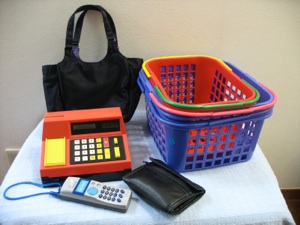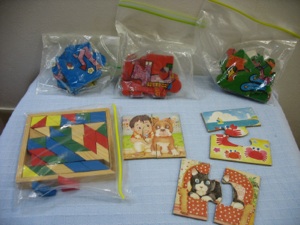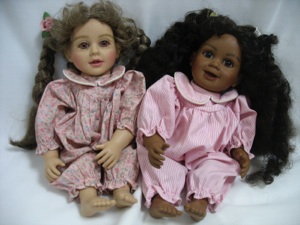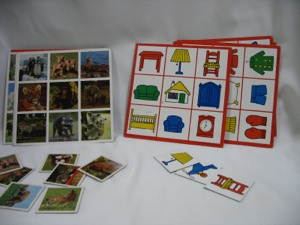
Fun Times with Toddlers
No matter what you do, you are your child’s favorite toy! They want to follow you around and do everything you do--you are teaching them every minute of every day whether you realize it or not! I tried to figure out ways to adapt what ever I was doing, so they could join in. I bought short brooms so they could sweep while I swept, and gave them a tub of soapy water to play with while i washed dishes. I also set a timer so that I would remember to stop working, and play with them--45 minutes to work, and 15 minutes to play. Perhaps I got less done, but my toddler was so much happier!
















Eating is such a big part of our day, it is not wonder that children love to pretend cooking and eating. It is so much more fun to drink tea WITH someone than to drink it all alone. So if Mommy joins, it becomes a real party! Dressing up like a princess can make it even more fun. Occasionally providing real food can make it an extra special treat.
Water play is fascinating to a toddler, and will keep them occupied for remarkably long periods of time. It inevitably makes a mess, but the trade-off of an hour of busy time for 5 minutes of clean up time is totally worth it in my book! It doesn’t have to be at the sink. Just provide different sizes of plastic cups and bowls, with small quantities of water to keep the mess to a minimum. If you have a plastic basin, it can help contain the mess. If it is warm, take the mess outside.
Toddlers learn by imitating you, so they want to do whatever you are doing. Try to think of ways or parts of cooking that they can do. When my girls were one and a half, I started them stirring what ever I was making. By the time they turned 2, they were adding ingredients that I pre-measured. By two and a half, they could fill measuring cups to the top. They can tear lettuce, wipe up spills, and fetch items from lower shelves.Yes, it makes more of a mess and takes more time when your toddler “helps.” But they are learning so much, it is worth a little extra mess!!
Reading to a child who can’t even talk yet may feel silly, but it is such a great way to teach them vocabulary and sentence structure! They will learn to talk so much faster if you will read a lot to them. Take advantage of libraries for lots of free reading material. Let your child choose some books so she can practice choosing, and you choose books that are just right for your child.
Begin with books that have simple pictures that you can point to and name. After you have read the book several times, begin to ask, “Where is the ball?” or “Point to the dog.” These are things they can do even before they can say the words, and you realize they have quite a large vocabulary of words that they can understand. You can make your own books by gluing magazine or catalog photographs into a notebook.
You can fairly quickly move onto simple stories that have one or two sentences per page. Flap books are especially fun for toddlers. You can make up simple stories about your toddler and use photos of your family to illustrate. These need to be sturdy because your toddler is sure to drag it everywhere and look at it often! “Red Hat, Green Hat” is a book that makes a two year old laugh every time you read it! If they don’t get it, wait a couple of months and try again.

Balls and balloons have lots of entertainment value, but even more, they teach wonderful eye-hand coordination. My son spent hours trying to hit a beach ball with his tiny plastic bat (yes, I was the pitcher!) By the time he was 3, he was connecting a smaller ball with the bat often enough that he didn’t get discouraged. A neighbor boy started at the same time as my son, but his mother got pregnant and quit pitching. By the time the baby was born and she resumed, he lost interest because he was old enough to realize he was missing most of the time. Throwing, catching, kicking, and even chasing after a ball are all important skills for all children, but especially for boys. By the time boys are school age, they get immediate acceptance by their peers if they are good with a ball. So invest that time now so they can reap the benefits later!
Toddlers learn by imitating you, so toy food and dishes make a fun toy that will entertain them for a long time. More than that, roll playing is an essential part of child development, so is important work for young children. You don’t have to buy expensive sets of dishes for kids to enjoy pretending. Many dollar stores sell cute sets in their toy section. Paper plates or disposable plastic plates work, too. Cut out color pictures of food from advertisements and glue them to thin cardboard to make it last longer. Look in your own cupboards for items that won’t break. Empty cans and boxes can help them pretend to cook, too. For example, when the box of cereal runs out, don’t throw the box away--put styrofoam packing peanuts in the box for your child to pretend to pour a bowl of cereal.
Shopping is another activity that they see you doing frequently. It is not too hard to give them the tools to imitate you. Old purses, wallets, and cell phones can be used as toys, or buy inexpensive items at dollar stores, or Goodwill stores. A toy cash register is not essential, but adds a lot of fun. Use small paper bags with handles rather than plastic bags to avoid suffocation dangers. I kept my unopened cans and boxes on lower shelves of the cupboard, so all i had to do was open a cupboard door to provide real items to complete their shopping experience.
A two year old is ready for 2 and 4 piece puzzles. When they are good at putting together individual puzzles, mix the pieces of several puzzles so they have to find the right parts to go together. When they are good at this, they are ready to move onto 12 or 25 piece puzzles. Shape sorters are another kind of puzzle that teaches the child to find matching shapes, as well as being able to rotate the shape to fit the hole. Nesting boxes and cups often have pictures on the sides for a matching activity that provide similar learning opportunities as well as learning about size.
Card sets that are puzzles are available as well--the child tries to find the matching head, body, and feet of different characters. You can make your own with photos of family members. Ask each person to stand against a blank wall, and take a photo that includes everything--from head to foot. When you get the photos developed, cut them into 3 parts. Help your child put the right head with the right body and feet. Then swap them around and laugh at the silly combinations such as baby’s head on daddy’s body and mommy’s feet. Make them even sillier by including photos of their dolls, stuffed animals, or even pets!
Toddlers are too young to play Concentration the real way. However, a set of these cards can help them learn vocabulary as well as the concept of “same” and “different.” Spread a few of the cards face up and pick up one card, and ask, “Where is the dog? Can you find the dog?” If your child picks up the wrong card, say, “No, that is different. Can you find the same card of the dog?” When they find the matching card, exclaim, “Yes! that is the same card! You found the dog card.” If your child has difficulty doing this, use fewer cards until he gets the hang of it, or wait a couple of months and try again.
Ravensburger makes all manner of games that toddlers can play. You can quite easily make your own bingo-style games now that color copying is so inexpensive. Look for photos on line, and make a grid of 3 rows of 3 items. Print out 2 each--one for the game board, and one for the pieces, which are cut apart. You can make them sturdier by glueing them to thin cardboard, or covering them with contact paper. To play the game, take turns picking out pictures and laying them on the corresponding picture on the board. At this age, you don’t need to win-- just doing it is fun. If you must have a winner, it can be the first with 3 in a row, or the first to fill the board. Categories for pictures might include clothing, furniture, animals, colors, etc. If your child is not interested, put them away and try again in a couple of months.
Many stores that sell toys or children’s clothing also sell educational card sets. Some cards teach colors, others focus on shapes, numbers, or what comes next in a sequence, etc., etc. They make teaching your toddler so fun and easy--you don’t have to come up with the ideas yourself! They also make activities that are easy to tote along for those times when your child needs to play quietly, whether it is in church or at the doctor’s office. They are relatively inexpensive, so why not buy a bunch? Just remember that there is no educational value unless you play the games with your child. Put them away as soon as your child looses interest, and it will stay fun.
“Relationshapes” are a bit pricey, but they teach a lot of concepts, and can be used for many years--if you are careful to put away all the pieces every time you use them!! They can be used to teach colors and shapes, as well as size relationships such as bigger, smaller, thicker, and thinner. The nicest thing is that there are workbooks that move your child through step by step learning. I am NOT suggesting that a 2 year old should be forced to do a workbook for an hour!! A two year old will have fun playing with the pieces with you for 5 or 10 minutes once or twice a week, and in the process, will learn all sorts of attributes. If these times are kept short and fun, by late 3, your child will be totally ready to place the shapes on the book as you explain. This is a teaching tool you use together with your child--if you let them play with them by themselves, no learning will take place at all, and the pieces will get lost in every corner of the house!
Little girls love a baby doll, especially if there is a baby on the way, or newly arrived. All the accouterments make it even more fun--diapers, diaper bag, baby bottle, stroller, baby carrier/back pack etc. Boys have no idea what to do with a doll in spite of what the experts claim--that we squeeze our children into our ideal of what a man or woman is supposed to be and do. My sister bought her sons dolls, but they used them as bombs to drop off of the bunk bed!! I thought for sure my son would play with dolls since his older sisters played with them incessantly. He may have played with dolls half a dozen times in his whole life, and when he did those few times, he had no idea what to do with them!! (Isn’t it funny that being relationally challenged doesn’t seem to change even in adulthood!!) Stuffed animals can make good doll substitutes for boys--they still won’t know what to do with them, but they make good companions to “watch” your toddler play.
Puppets can be a fun way to encourage your child to talk, though often it degenerates into the toddler feeding the puppet toy food, and the puppet ends up eating it Cookie Monster style, then the puppets end up eating each other (especially when daddies are the puppeteering partner!). A puppet was a HUGE help to me when my daughter would wake up from a nap cranky, and refuse to talk to me. She was quite happy to talk to the puppet, and the novelty of it distracted her so that she became sweet much more quickly than if i had tried to cajole her without it.
Puppets don’t have to cost a lot of money--these are dollar store oven mitts in the shape of animals. You can make sock puppets for even less if you can find socks at a dollar store.
Bubble are magic!
Whether it’s a crying 2 year old who needs distracting, or a bored 4 year old, bubbles can change a mood in an instant! It can be frustrating for younger children who want to blow bubbles, but can’t quite get the hang of it, or the parent who is desperately trying to get bubbles to appear, and for some inexplicable reason, they won’t. There is a solution--stores (like Walmart) now sell inexpensive gadgets that blow for you--all you have to do is dip them in the provided solution and pull the trigger (well, you do have to put the batteries in before you start!) The package claims that the bubbles fly higher and last longer--and they really do!!

Family Fun > Fun for Kids age 1-3
Family Fun > Fun for Kids age 2-3




